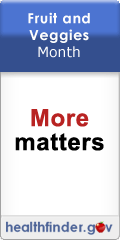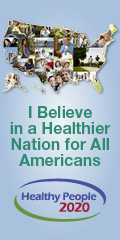Family Health

![]()
In the Spotlight
Keep Kids Safe and Healthy This Summer
It’s summertime! Be extra vigilant to prevent injury and keep your kids safe and healthy this summer.
Become a Text4Baby
Partner
Text4baby delivers free health tips three times a week via cell phone text
messages to pregnant women and new moms. The free messages are timed to a
woman's due date or the baby's date of birth. Find out what you can do to
help raise awareness and become an outreach partner.
Kids’ Health
RSS
Stay updated with new content from CDC on kids’ health. From this page you can subscribe to CDC or other US Government RSS feeds or view content directly on this page without having to use an aggregator. Subscribe
to the Kids’ Health RSS feed.
Healthy Families
Keep Your Cool in Hot Weather
Learn more about heat-related illness and how to stay cool and well in hot weather.
Healthy Pets Healthy People
There are many positive benefits of owning a pet; however, it's important to know that some animals may carry germs that can be spread to people and cause illness.
Tourette Syndrome: Mike's Story
Read Mike's story and find out what CDC is doing to raise awareness and educate health and education professionals about Tourette Syndrome. 3 of every 1,000 children 6 through 17 years of age have been diagnosed with Tourette Syndrome; this represents approximately 148,000 U.S. children.
Healthy Communities
Training Tools for Healthy Schools
CDC's Training Tools for Healthy Schools help improve school health policies, programs, and curricula. Learn how these workshops promote health and academic success.
DEET, Showers, and Tick Checks Can Stop Ticks
Reduce your chances of getting a tickborne disease by using repellents, checking for ticks, and showering after being outdoors. If you have a tick bite followed by a fever or rash, seek medical attention.
Motorcycle Safety Guide
In this guide, learn the best way to protect riders, increase motorcycle safety, and how your state compares to others.
Science and Research
Youth Risk Behavior Surveillance - United States, 2011
Results from the 2011 national YRBS indicated that many high school students are engaged in priority health-risk behaviors associated with the leading causes of death among persons aged 10-24 years in the United States. Variations were observed in many health-risk behaviors by sex, race/ethnicity, and grade.
Deaths: Final Data for 2009
Death rates among females declined for the age groups less than 1 year, 55-64, 65-74, 75-84, and 85 years and over. For females, the death rate increased for ages 25-34 and 45-54 years.
Previous HIV Testing Among Adults and Adolescents Newly Diagnosed with HIV Infection - National HIV Surveillance System, 18 Jurisdictions, United States, 2006-2009
Groups with the highest percentage of persons testing HIV-negative ≤12 months before HIV diagnosis included those aged 13-29 years (33%), males with HIV transmission attributed to male-to-male sexual contact (29%), and whites (28%).
Helmet Use Among Motorcyclists Who Died in Crashes and Economic Cost Savings Associated With State Motorcycle Helmet Laws - United States, 2008-2010
The findings indicated that, on average, 12% of fatally injured motorcyclists were not wearing helmets in states with universal helmet laws, compared with 64% in partial helmet law states (laws that only required specific groups, usually young riders, to wear helmets) and 79% in states without a helmet law.
Neonatal Herpes Simplex Virus Infection Following Jewish Ritual Circumcisions that Included Direct Orogenital Suction - New York City, 2000-2011
Based on cases reported to the New York City Department of Health and Mental Hygiene during April 2006-December 2011, the risk for neonatal herpes caused by HSV-1 and untyped HSV following Jewish ritual circumcision with confirmed or probable direct orogenital suction in New York City was estimated at 1 in 4,098 or 3.4 times greater than the risk among male infants considered unlikely to have had direct orogenital suction.
Measles Outbreak Associated with an Arriving Refugee - Los Angeles County, California, August-September 2011
This outbreak emphasizes the importance of maintaining a high level of vaccination coverage and continued high vigilance for measles in the United States, particularly among incoming international travelers; clinicians should immediately isolate persons with suspected measles and promptly report them to health authorities.
CDC Grand Rounds: Newborn Screening and Improved Outcomes
Each year, >98% of approximately 4 million newborns in the United States are screened. Through early identification, newborn screening provides an opportunity for treatment and significant reductions in morbidity and mortality.
Notes from the Field: Norovirus Outbreak at a Boys' Basketball Tournament - Kentucky, February 2012
State and local health officials partnered with CDC in an investigation to determine the extent of the outbreak, confirm the cause, and assess potential modes of transmission.
Trends in Asthma Prevalence, Health Care Use, and Mortality in the United States, 2001-2010
For the period 2008-2010, asthma prevalence was higher among children than adults, and among multiple-race, black, and American Indian or Alaska Native persons than white persons.
![]() This site contains documents in PDF format. You will need Adobe Acrobat Reader
to access the file. If you do not have the Acrobat Reader, you may download a
free copy from the Adobe Web site.
This site contains documents in PDF format. You will need Adobe Acrobat Reader
to access the file. If you do not have the Acrobat Reader, you may download a
free copy from the Adobe Web site.
Content Source: CDC Office
of Women’s Health
Page last modified:
July 9, 2012
Page last reviewed: July 9, 2012



